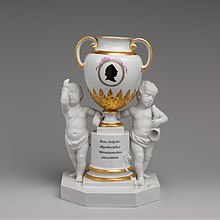Karl Theodor Anton Maria von Dalberg
This article needs additional citations for verification. (December 2018) |
Karl Theodor Anton Maria von Dalberg | |
|---|---|
| |
| Previous post(s) | Titular Archbishop of Tarsus (1788–1800) |
| Signature | |
| Coat of arms |  |
Karl Theodor Anton Maria von Dalberg (8 February 1744 – 10 February 1817) was a
Early life and career

Born in
Having been appointed in 1772 governor of Erfurt, he won further advancement by his successful administration.[3] He was rector of the cathedral school in Würzburg in 1780.[2]
In 1787 he was elected
As statesman, Dalberg was distinguished by his patriotic attitude, whether in ecclesiastical matters, in which he leaned to the Febronian view of a German national church, or in his efforts to galvanize the atrophied machinery of the Holy Roman Empire into some sort of effective central government of Germany. Failing in this, he turned to the rising star of Napoleon, believing that he had found in him the only force strong enough to save Germany from dissolution.[1]
By the
In the
This was, of course, the decision of a state authority which, in its spiritual part, could not take effect until ratified by the Pope; in any case, Regensburg's bishop, Josef Conrad of Schroffenberg-Mös, was still alive at the time. So, Dalberg did not exercise spiritual authority in the older part of the Regensburg diocese until Bishop Schroffenberg died, at which point he made himself elected
Prince-Primate of the Confederation of the Rhine
After the dissolution of the Holy Roman Empire in 1806, Dalberg together with other princes joined the
After the Treaty of Schönbrunn (1810), he was elevated by the French to the rank of Grand Duke of Frankfurt.[1] This greatly augmented Dalberg's territories, although he had to cede Regensburg to the Kingdom of Bavaria. As Grand Duke of Frankfurt he ordered all restrictions on the Jews of Frankfurt lifted. This was opposed by the Lutheran town council, until 1811, when Dalberg issued a proclamation ending the requirement that Jews live in the ghetto or pay special taxes.[citation needed]
On 14 January 1806 he performed the wedding of
Death and legacy
Dalberg died in 1817 in Regensburg. Although his political subservience to Napoleon was resented by a later generation in Germany, as a man and prelate he is remembered as amiable, conscientious and large-hearted. Himself a scholar and author, Dalberg was a notable patron of letters, and was the friend of Goethe, Schiller and Wieland.[1]
Notes
- ^ a b c d One or more of the preceding sentences incorporates text from a publication now in the public domain: Chisholm, Hugh, ed. (1911). "Dalberg § 2. Karl Theodor Anton Maria von Dalberg". Encyclopædia Britannica. Vol. 7 (11th ed.). Cambridge University Press. pp. 762–763.
- ^ a b c Bischof, Franz Xaver. "Dalberg, Karl Theodor Anton Maria v.", Religion Past and Present, 2013
ISBN 9789004146662
- ^ a b "Karl Theodor Anton Maria von Dalberg ", Art of Travel - 1500-1850, NUI Galway
- ^ a b c "Karl von Dalberg, Archbishop of Mainz and Prince Primate", The British Museum
- ^ "Dalberg, Carl Theodor Anton Maria von", Haus der Bayerischen Geschichte
External links
- . Encyclopædia Britannica. Vol. 6 (9th ed.). 1878.
